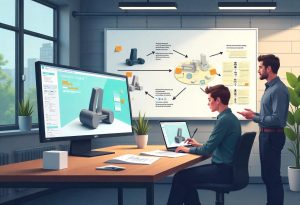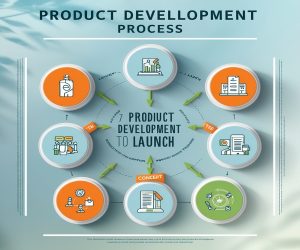Table of Contents
- Introduction to Product Development
- Why the Product Development Process is Crucial
- Key Stages of the Product Manufacturing Process
- Step 1: Conceptualization
- Step 2: Market Research
- Step 3: Prototyping
- Step 4: Testing and Validation
- Step 5: Manufacturing and Production
- Step 6: Launch and Feedback
- Common Challenges in Product Manufacturing
- Practical Examples of Successful Product Manufacturing
- Tools and Resources for Product Manufacturing
- FAQs About Product Development
- Conclusion and Call-to-Action
Introduction to Product Development
Product development refers to the entire process of bringing a new product to market, from ideation to final production. It’s a systematic approach to solving real-world problems while meeting customer needs. Whether you’re designing a groundbreaking gadget or creating a consumer app, Product Manufacturing transforms your idea into a tangible product ready for users.
This journey involves creativity, technical expertise, and strategic planning to ensure your product not only meets market demands but also excels in functionality and quality.
Why the Product Development Process is Crucial
A structured product development process offers numerous benefits, including:
- Risk Mitigation: Identifying and addressing potential challenges early.
- Cost Efficiency: Avoiding unnecessary expenses by prioritizing essential features.
- Market Fit: Ensuring the product aligns with customer needs and preferences.
- Quality Assurance: Delivering a reliable and polished final product.
Investing time in a clear Product Manufacturing process increases your chances of success, whether you’re an entrepreneur or part of a large organization.
Key Stages of the Product Development Process
Step 1: Conceptualization
Every product starts with an idea. Conceptualization involves brainstorming and refining your vision:
- Identify the Problem: What issue does your product aim to solve?
- Understand the Audience: Who will benefit from this product?
- Visualize the Solution: Sketch ideas and draft possible features.
Step 2: Market Research
Research ensures your product addresses a real need and has a viable market. Consider:
- Competitor Analysis: Study similar products to identify gaps.

- Customer Insights: Conduct surveys, focus groups, or interviews.
- Trend Analysis: Look at industry reports to understand emerging needs.
Step 3: Prototyping
Prototyping turns your concept into a functional model. Key actions include:
- Low-Fidelity Prototypes: Start with sketches or wireframes.
- High-Fidelity Prototypes: Use 3D printing or software tools for realistic models.
- Iterate Quickly: Refine the prototype based on initial feedback.
Step 4: Testing and Validation
Test the prototype with potential users and stakeholders:
- Usability Testing: Ensure it’s user-friendly and solves the intended problem.
- Stress Testing: Identify performance and durability issues.
- Feedback Loop: Gather input and improve the design iteratively.
Step 5: Manufacturing and Production
Once the design is finalized, move to production:
- Select Materials: Choose components that balance quality and cost.
- Find Suppliers: Partner with reliable manufacturers.
- Set Up Quality Control: Inspect products to ensure consistency.
Step 6: Launch and Feedback
Finally, introduce the product to your target market:
- Soft Launch: Release to a limited audience to gather final feedback.
- Full Launch: Market the product extensively.
- Post-Launch Review: Use customer insights to plan updates or new features.
Common Challenges in Product Development
- Undefined Goals: A lack of clarity about what the product aims to achieve.

- Resource Constraints: Limited time, budget, or manpower.
- Over-Engineering: Adding unnecessary features that complicate the product.
- Market Misalignment: Misjudging the target audience or demand.
- Poor Communication: Gaps between teams during development.
By anticipating these challenges, you can create strategies to overcome them efficiently.
Practical Examples of Successful Product Development
Example 1: Dyson Vacuum Cleaners
James Dyson’s journey involved over 5,000 prototypes before creating the first bagless vacuum cleaner. His persistence and attention to detail revolutionized the market.
Example 2: Tesla Model S
Tesla’s electric car evolved through continuous feedback, starting with prototypes that prioritized energy efficiency and sleek design.
Example 3: Post-it Notes
Originally a failed adhesive experiment, Post-it Notes became a global success after employees discovered its practical uses during daily work.
Tools and Resources for Product Development
| Tool Type | Examples | Purpose |
|---|---|---|
| Prototyping Software | Figma, Sketch, AutoCAD | Designing product models |
| Market Research Tools | Google Trends, SurveyMonkey | Understanding market needs |
| Project Management | Trello, Asana | Organizing development process |
| Manufacturing Platforms | Alibaba, ThomasNet | Finding suppliers and materials |
| Testing and Validation | UserTesting, Applause | Gathering user feedback |
FAQs About Product Development
Q1: What is the first step in Product Manufacturing?
The first step is conceptualization, where you brainstorm ideas and define the core problem your product will solve.
Q2: How long does the Product Manufacturing process take?
The timeline varies depending on the complexity of the product but typically ranges from a few months to a couple of years.
Q3: Can I develop a product without a prototype?
While possible, skipping the prototyping stage increases the risk of design flaws and market misalignment.
Q4: What industries benefit most from structured product development?
Industries like technology, manufacturing, consumer goods, and healthcare rely heavily on structured Product Manufacturing to ensure quality and innovation.
Q5: What is the role of feedback in product development?
Feedback helps identify strengths and weaknesses, ensuring the final product meets user needs effectively.
Conclusion
Mastering product development is key to turning ideas into market-ready solutions. By following a structured Product Manufacturing process, you can minimize risks, save resources, and create products that resonate with your audience.
Ready to get started? Explore tools like Figma for design, Trello for project management, and UserTesting for feedback to make your Product Manufacturing journey smoother. For more insights, check out our resources on effective product strategies and tips!
